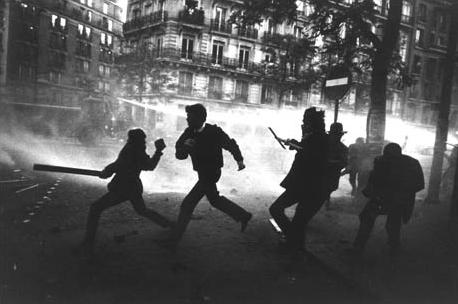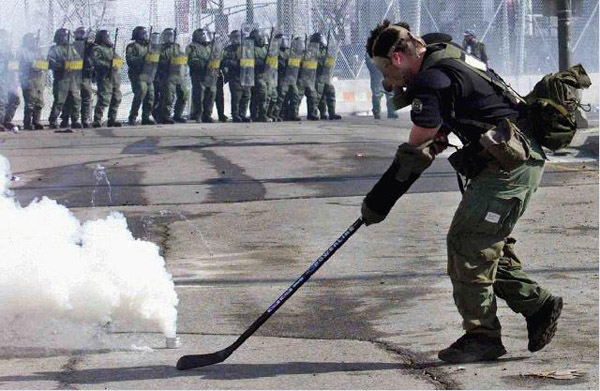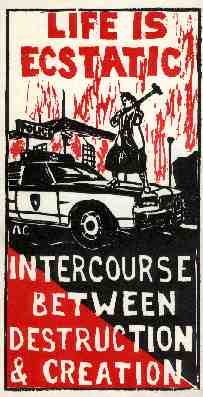|
|||||||||||||
|
the Measurement of Social Revolutions
Discovering an Algebraic Expression By Punkerslut
The Law of "F = M * A"
Force is mass multiplied by acceleration, or "F = MA." This is Isaac Newton's Second Law of Motion, and today, it is a core component of our understanding of Physics. The force of a body is its matter times its ability to change speed. It is this force that is necessary when trying to accomplish a change in the physical conditions of the world. And when we are describing revolutionary struggles of the working people against Capitalism, the law of "F = MA" still holds true. There are two components, then, that make up the power of the revolutionary masses. First, there is the size of the movement. There is the number of people, associations, and groups, interlocking with each other with one person often in many organizations. And second, there is the acceleration of the revolutionary people. It is not simply a matter of speed, but the rate of change of speed. A powerful speed means going very fast, but a powerful acceleration means being able to go fast from a stand-still position in a very short amount of time. Force, then, depends upon how quick and widespread our action is when the revolution begins, and not necessarily just the speed of the revolution. With these two components, mass and acceleration, we can gage the true force of a revolutionary movement -- just as the same laws apply to the motion of planets, moons, and satellites. Yet, it is a multiplication. Force is not the addition of mass and acceleration, but their multiplication. So, if either mass or acceleration are very small, then the force will be very close to nothing at all. Any number, multiplied by a very small fraction, like 0.01 or 0.001, will similarly produce another insignificant number. So, even if the mass is great, it will produce little force, if acceleration is little. And, even if the acceleration is great, there will still be little force, if the mass is lacking. Consider the example of a mosquito, which is able to increase its speed by 10 miles-per-hour every second. Even with such a powerful acceleration, if it hit you finally at 500 miles-per-hour, its mass would be too small to really impose any force on your body. And, consider the example of a train, carrying thousands of tons of coal and steel, but slowly picking up pace, at a rate of 1 mile-per-hour every minute. Its force will certainly not be too great. Even though both of these examples show either great mass or great acceleration, there is a significant lack of force compared to what may have been possible. The single insect, buzzing at a thousand miles-per-hour, explodes upon impact, but makes no visible impression -- like a genius in the Dark Ages, such as Galileo or Bruno who challenged the Catholic Church. The revolution was not made, because there was so little mass, even though the members of the revolution clearly were some of the most brilliant and active minds through human history. Great acceleration, but little mass, leads to a very weak force. Though such speakers made their impression, like the exploded insect, their lack of mass in the revolution prevented them from having enough force to change the world. The train, too, that slowly comes up to speed over a long distance, resembles revolutionary movements of the past: those that possessed their mass, but did not possess the necessary acceleration. These failed revolutions of large masses, though, are less known than the failed revolutions of accelerated individuals. The Chartist Movement in the 1800's of England represented a mass, working class movement. Its official demands were limits on government and universal voting, but in its union meetings, it demanded greater protections and securities of the working class. [*1] Such a movement certainly made its impact, but it really halted from being revolutionary. It could not demand the abolishment of either state or capitalism, nor could it demand anything more than a higher niche for the working class in the present system. Its acceleration was weak, and after putting its faith in the magistrates of king and god, it was violently crushed with bayonet and rifle. In Italy of 1920, the masses of people were against Fascism to the point where anywhere between 70% and 80% of the votes went to Socialist Parties. [*2] [*3] Yet the acceleration of the Fascists here beat that of the Socialists; for the Socialists condemned the workers, when they seized factories, but the Fascists awarded medals to their party members for acts of arson and murder against the opposition. The Italian Socialist movement lacked the acceleration that would have allowed it force to change its world, even though its mass was undisputed. And with this weakness, Italian Socialism was trampled upon and killed by Fascism.
The Law of "W = F * D"
Newtonian Physics continues with the law of work, "W = FD," or if we substitute force in this equation, we get "W = MAD." This translates to: work is equal to the force multiplied by the distance. The phrase "work" as a measurement of how much distance has been covered by force has been in use for less than two centuries, coined by the French physicist Gaspard-Gustave Coriolis in 1826. [*4] [*5] The use of such a concept in engineering and machinery should be obvious. Those who designs factories and mines know how to calculate the force of their machines, but they are not told how much force they need -- they're only told that an assembly line needs to carry goods across 40 feet, or that an elevator needs to be pulled up by six flights. This formula of "W = FD" provides a way for the engineer to translate the actual, physical force of the machine they're designing with the amount of distance it's supposed to cover. After all, if an elevator or assembly line applies too much force, it will not work according to the engineer's designs. In terms of the working people, "white-collar" and "blue-collar," force is not used to determine how much work is done -- force is used to determine the success of the Revolution. The word "distance" can still be kept, though it's meaning is somewhat different. Our formula, then, would be: "The Revolution = Workers' Force * Distance Covered by the Revolution." This distance is a more abstract distance: a revolution covers more territory when workers seize more factories, students seize more schools, and the people seize more homes. If we wanted to substitute force for mass multiplied by acceleration, our formula would look like: "The Revolution = Mass of the Revolutionary Movement * Acceleration of the Revolutionary Movement * Amount of Society Changed by the Revolutionary Movement." It's basic, textbook Physics. The revolution is the force of the working class multiplied by the distance of society that they have covered in their changes. The force, which is the revolution's mass and acceleration, is the strongest variable that determines the extent and depth of the revolution. Without a revolutionary mass, there can be no revolution. With "F = MA," we know that the force of a people is a relationship between mass and acceleration, or their size and the depth of their revolutionary activity. And, with "W = FD," we know that the revolution of a people is between their force and distance, or their strength and the extent of society covered by revolutionary activity.
The Law of Constant Agitation
The first law of physics equally applies to our principles of revolutionary organizing. Briefly stated, it is: "An object at rest tends to stay at rest, and an object in motion tends to stay in motion." Or, as far as the engineer is concerned: "It takes more energy to move an object at rest, than it does to keep a moving object in motion." Yet, there is an interesting curiosity about this law. Like some of the other laws developed by Newton, it is an "ideal law," dealing with "ideal conditions." Or, more specifically, it is a law that is based on situations that cannot ever exist in the real world. Almost all of the laws concerning energy, electricity, and heat, likewise, are based on situations that cannot exist in reality, but only make up a basic guideline for measuring it. In terms of this law, there is no such thing as "an object at rest," as objects are at rest with regards to some other objects; but, they are always in motion, when it comes to regarding the rest of the universe. Yet, this "ideal law" provides some useful interpretation of our physical world -- engineers who design machines, knowing that the parts may be in motion or at rest in regards to each other, can use this principle. But there is no object truly at rest as far as the universe is concerned. It is a meaningful principle, which can help in analyzing very small, closed-systems, but it does not hold in regards to the universal system. And, so, likewise, I wish to interpret this law in terms of its social, economic, and political implications. A society at rest tends to stay at rest, as a society in motion tends to stay in motion. Empires did not suddenly rise out of nothing, nor did they suddenly collapse in an instant. Even those empires which are seen as falling from an invasion from outside, actually, have endured a long period of decline, before they became too weak to defend themselves from attack. At one point, European Kings had to beg the Pope for the right of heaven to rule, but after several centuries, this role was entirely reversed, as those the torch of tyranny was grasped out of the hands of the dying empire. While it is fair to say that the domination of Catholicism has been on the decline for the past few centuries, the timeline for the fall of European and American nation-states isn't completely obvious yet. Or, perhaps, it is now stuttering through its climax, before the decline. The rule of every object tending to stay in motion or at rest, however, does not explain why any social force changes, from decline to rise, as in the case of the Ancient Roman Empire. It is as in the case of applying this law of physics to the world. In the closed system, where we shut out external influences, yes, we can say that a particular society remains at rest or in motion. But it is only a tendency and not an absolute. As when objects interact with each other, the tendency will be changed from motion in one direction to motion in another, or perhaps even to put the object at rest. Servility and slavery will lead to servility and slavery, but this is no closed system, as the interaction of slaves with their slavery produces friction. The Romans believed they could keep slavery, and maintained this institution for some time, believing the object at rest to stay at rest. But as the slaves became agitated, educated, and organized, revolt became imminent. Here, we can see the laws of Thermodynamics, in the production, storage, and dissipation of heat, or we may even borrow the electrical laws, for capacitance and charge-storage or for resistance and voltage-release. The Romans, imagining that slavery tends toward slavery, did not see the motion of the slaves and their revulsion at Roman tyranny. While the institution of slavery was at rest, it was the activity of the slaves' minds that brought about an insurrection of millions of slaves. [*6] There are some uses of this First Law of Newtonian Physics, but for a universal, inclusive system, it is better to adopt the Law of Constant Agitation. Nothing remains at rest, everything changes. Languages can last thousands of years and currencies can last hundreds of years, but with every word and every purchase, the meaning of these institutions is constantly changing. Such a law in terms of social interactions is much more like the Third Law of Newtonian physics, also the last one, briefly stated as: "every action has an equal and opposite reaction." Or, in a system where motion is everywhere, it can mean constant agitation. If you want to bring about the revolution, then you will need to use these laws to your advantage. You must know the importance of both the revolutionary masses and their acceleration -- their size and their quickness in revolution. Where the people are ready to dispose of Capitalism, the insurrection must sweep through cities and counties like a gasoline-fueled fire. The General Strike cannot be taken lightly by the revolutionary masses, but its substance must be with factory seizures and land occupations, barricaded city blocks and raided parliaments. It is not simply a matter of convincing everyone of the value of a world free of exploitation and oppression, but convincing them to act meaningfully to create it. The true force of the workers is in these principles of mass and acceleration. The revolution we are going to achieve is going to be based on the strength of this force, and how much it is willing to cover. Using these formulas, one can essentially understand where the revolution fails, or what is necessary to make it succeed. Punkerslut,
Resources *1. "The British General Strike - Its Place in History," by August Thalheimer, Source: The Communist International, No. 22, 1926, pp. 42-58. Section: "Class Struggles during the Development of Big Industry -- Chartism."
|






